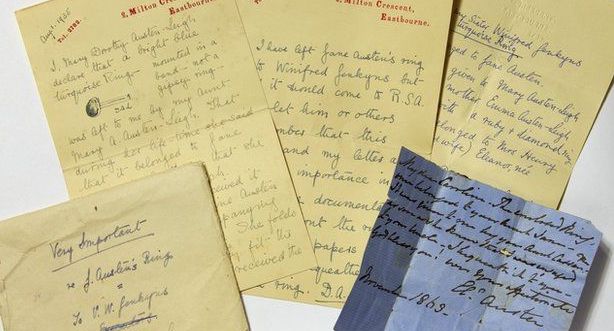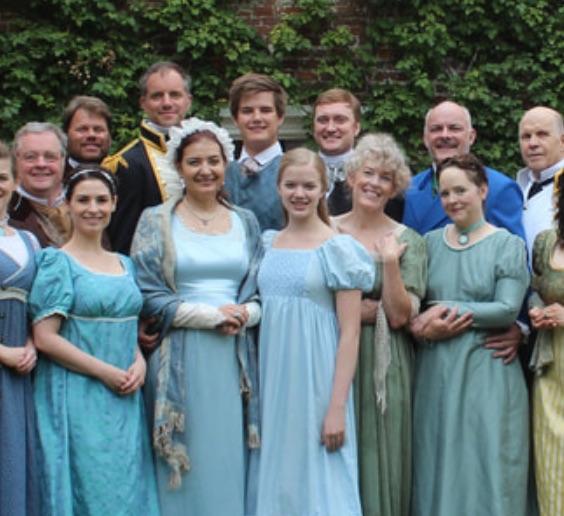The Jane Austen Turquoise Ring - The History
The Jane Austen Turquoise Ring

There are only three referenced pieces of jewellery which we know belonged to and were worn by Jane Austen. Few mentions are made of her jewellery within the letters written by Jane or to Jane, so it's unknown how many pieces of jewellery owned by her may have existed but been lost over time. However, given Jane's relatively modest means throughout her life, it's fair to suppose that her collection of jewellery would not have been vast. This makes the pieces which we do know of - the topaz cross (given to Jane by her brother Charles in 1801), the blue glass-bead bracelet (a seven-inch long, one-inch wide bracelet made of six strands of beads fastened with a gilt clasp), and the turquoise and gold ring, that much more precious. Of these three, the turquoise and gold ring is by far the most iconic. 

What is the Jane Austen turquoise ring made of?

The ring has a vibrant blue stone which contains no obvious blemishes or veins in it. Originally it was speculated that the stone may not be turquoise, but was rather a stone called Odontalite - a cheaper substitute for turquoise. However, when Sotheby's auction house examined the ring more closely prior to selling it (more on that later), it was proven to be genuine turquoise. This gave rise to ask who it was who had given Jane the ring. Whether she bought it for herself, or whether it was a gift from one of her brothers, or even whether it may have been an engagement ring (though this would be highly surprising given that the closest she came to a known engagement was with her fiance of approximately twelve hours; Harris Bigg-Wither).
Whatever the origin of the ring, the stone being that of turquoise is significant. In Western countries, turquoise is the stone traditionally given to those born in December - Jane was born on the 16th of December in 1775. It was also a stone which was becoming more readily available and popular throughout the Regency period, thanks to the easy trade routes which were in place from Egypt and Africa. The turquoise stone is set in a small gold plain band. Its petite size gives us an idea of how dainty Jane’s hands would have been. The ring is thought to have been created between 1750 and 1800.
What happened to the Jane Austen turquoise ring after her death?
Immediately following Jane's death in 1817, the ring was kept by Jane’s sister Cassandra. Then, in 1820, Jane's brother Henry remarried following the death of his first wife (Jane's cousin Eliza de Feuillide). Cassandra presented the ring as a gift to Henry's new wife, Eleanor Jackson. The next Austen who the ring passed to was Jane’s niece, Caroline Austen. It was given to her in 1863, a year before Eleanor's death, along with a note, which still accompanies the ring today. 
The note reads thusly: "My dear Caroline. The enclosed Ring once belonged to your Aunt Jane. It was given to me by your Aunt Cassandra as soon as she knew that I was engaged to your Uncle. I bequeath it to you. God bless you!"
The ring continues to be passed down through the Austen family, before it was put up for auction by Sotheby's auction house in 2012. The ring was famously purchased by the American pop singer, Kelly Clarkson. She paid £152,450 for the ring; which was over five times the reserve price of £30,000. The ring might have vanished once more from the public eye from that moment, were it not for a piece of legislation which was invoked by Ed Vaizey, the Culture Minister at the time. He placed an export ban upon the ring which stopped it from leaving the country. The other thing which this ban meant was that there was a period of time during which UK museums or consortiums could raise money in order to try and match what Clarkson had paid for the ring and stop it from being sold
How did the export ban work?
The ring was classed as 'Cultural Goods', i.e. a work of art which could not pass freely in and out of the UK. The ring was deemed as such since it was more than fifty years old and of high value. Any 'Cultural Good' which is sold to a foreign buyer, or is due to leave the UK for sale elsewhere, requires an export license. During the license process, the cultural good is evaluated to determine whether or not it is a 'National Treasure'.
To be a ‘National Treasure’, the object must meet one or more of the three ‘Waverley Criteria’. These are:
- Historical importance: is it so closely connected with our history and national life that its departure would be a misfortune?
- Aesthetic importance: is it of outstanding aesthetic importance?
- Importance for scholarship: is it of outstanding significance for the study of some particular branch of art, learning or history?
If it is a National Treasure, a temporary export bar can be placed on the object. This gives UK institutions up to a year to raise funds to match the foreign offer. If that happens, then the foreign buyer can either sell the object or withdraw the application for an export license. They will retain ownership, but they will have to keep the object in the UK. If they choose this path, they can’t request another export license for ten years.
A campaign to keep the Jane Austen turquoise ring was launched following the announcement of the temporary ban. In 2013, the ring, along with its box and its letters of authenticity, were bought by Jane Austen's House Museum in Chawton. The campaign raised £157,740 in total following donations from around the world, and one anonymous donation of £100,000.

Replicas of the Jane Austen turquoise ring are available to buy and can be found in the Jane Austen Online Gift Shop here.
****



1 comment
Excellent article. Well written and interesting
Fiona Martin
Leave a comment
This site is protected by hCaptcha and the hCaptcha Privacy Policy and Terms of Service apply.